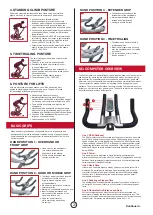
1
Saddle
2
Forward/Backward Seat Adjustment T-Handle
3
Up/Down
Seat Adjustment T-Handle
4
Sturdy Base
5
Multi-Functional Computer
System
6
Resistance Shifter
7
Dual Placement Handlebars
8
Sweat Guard
9
Up/Down Handlebar Adjustment T-Handle
10
Belt Cover
11
Water Bottle Holder
12
Shimano
TM
Combo Pedals
13
Easy Transport Wheels
2
2
3
10
4
11
12
13
BEFORE YOU START
Before starting on any course of exercise, please consult your Doctor who
should be able to advise on the suitability of this form of exercise and on any
particular risks for you with indoor cycling.
Please familiarise yourself with the fixed wheel nature of the bike and with the
position and operation of the emergency brake before using the machine for
exercise. Any other users of this bike must also be instructed in the safe use
of the equipment.
NOTE:
The spinning flywheel, hubcaps etc are made of a soft metal
alloy. They are susceptible to impact damage and marking from
sharp objects. Please be extremely careful with the entire machine,
but most particularly these soft alloy parts. Remember, damage
beyond normal wear and tear must be paid for!
ADJUSTING YOUR BIKE FOR PERFECT FIT
HANDLEBAR HEIGHT ADJUSTMENT
Adjustments to the bike MUST NOT be made whilst you
are on the bike.
Only adjust the handlebars after performing
seat height adjustment above. Handlebars
should be level or higher than the top of the
saddle. Elbows should be slightly bent. If you
are new to cycling it is more comfortable to
keep the handlebars in a higher position to
keep any strain off your back. As your
experience increases you may wish to drop the
handlebars, but never drop lower than the tip
of your saddle. To do so will overstress arms,
mid-back and neck.
SEAT HEIGHT POSITIONING
Stand by the side of your bike and adjust the top of the saddle to be level with
the top of your hip. Now get on the bike and confirm a 5 to 15 degree bend in
your knee when the pedal is at its lowest point.
NOTE:
Hips should not rock back and forth
in the saddle with each pedal stroke. Seat
position may be too high. Knees should
never be in a locked out (overextended)
position. Conversely, if knees are bowed
outward the seat may be too low. If knees
are too flexed, unwanted stress is placed on
the knee caps.
NOTE:
This is a fixed wheel machine. This means that there is no ‘free
wheel’ facility. When you stop pedalling, the pedals and crank arms will
continue to rotate, until friction, braking or your efforts bring them to a
stop. In an emergency the pedals can be stopped by moving the gear
shifter upward and forward beyond the highest gear. This engages an
emergency brake directly on to the spinning flywheel. Do not try to
remove your feet from the pedals until the pedals have come to a
complete stop. Failure to comply with this may result in injury.
Continued
>
1





















